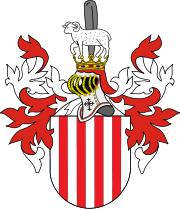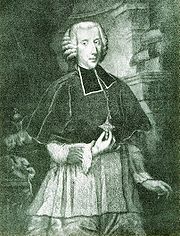
House of Schaffgotsch
Encyclopedia

Nobility
Nobility is a social class which possesses more acknowledged privileges or eminence than members of most other classes in a society, membership therein typically being hereditary. The privileges associated with nobility may constitute substantial advantages over or relative to non-nobles, or may be...
Silesia
Silesia
Silesia is a historical region of Central Europe located mostly in Poland, with smaller parts also in the Czech Republic, and Germany.Silesia is rich in mineral and natural resources, and includes several important industrial areas. Silesia's largest city and historical capital is Wrocław...
n families extant, dating back to the thirteenth century. They were first mentioned in the St. Gallen
St. Gallen
St. Gallen is the capital of the canton of St. Gallen in Switzerland. It evolved from the hermitage of Saint Gall, founded in the 7th century. Today, it is a large urban agglomeration and represents the center of eastern Switzerland. The town mainly relies on the service sector for its economic...
book of documents in 804 and 809, when they were domiciled in the Margraviate of Meissen, Franconia
Franconia
Franconia is a region of Germany comprising the northern parts of the modern state of Bavaria, a small part of southern Thuringia, and a region in northeastern Baden-Württemberg called Tauberfranken...
, and the Tyrol
County of Tyrol
The County of Tyrol, Princely County from 1504, was a State of the Holy Roman Empire, from 1814 a province of the Austrian Empire and from 1867 a Cisleithanian crown land of Austria-Hungary...
. Around 1240, the first Schaffgotsch appears in a Silesian document as Sibotho ""de nobili Familia Ovium" ("ovium" is the Latin word for "sheep", the translation of the German word Schaf(f)). According to tradition, Sibotho came in the entourage of Hedwig of Andechs
Hedwig of Andechs
Saint Hedwig of Silesia , also Saint Hedwig of Andechs from the comital House of Andechs was Duchess of Silesia from 1201 and of Greater Poland from 1231 as well as High Duchess consort of Poland from 1232 until 1238.-Life:...
and Henry I the Bearded
Henry I the Bearded
Henry I the Bearded , of the Silesian line of the Piast dynasty, was Duke of Silesia at Wrocław from 1201 and Duke of Kraków and thus High Duke of all Poland - internally divided - from 1232 until his death.-Heir of Wroclaw:...
.
One of Sibotho's successors, the knight Gotsche II Schoff (who died in 1420), bought extensive possessions in the foreland of the Riesengebirge Giant Mountains
Karkonosze
Krkonoše is a mountain range located in the north of the Czech Republic and the south-west of Poland, part of the Sudetes mountain system . The Czech-Polish border, which divides the historic regions of Bohemia and Silesia, runs along the main ridge...
and Iser Jizera Mountains
Jizera Mountains
Jizera Mountains , or Izera Mountains, are part of the Western Sudetes on the border between the Czech Republic and Poland. The major part is formed from granite, with some areas formed from basalt. The mountains got their name from the Jizera River, which rises at the southern base of Smrk...
at the end of the fourteenth century: the Kynast
Chojnik
Chojnik Castle is a castle located above the town of Sobieszów, today part of Jelenia Góra in southwestern Poland. Its remains stand on top of the Chojnik hill within the Karkonosze National Park, overlooking the Jelenia Góra valley....
and Greiffenstein dominions. In 1403, Gotsche II donated the church at Warmbrunn to the Cistercian provost. His family cherished the memory of Gotsche II Schoff, the originator of their wealth, by adopting the sobriquet "Gotsch". Later, both names were connected as Schaffgotsch.
Gotsche II's son Hans (who died in 1469) was the first of the family to be chancellor, court judge, and governor of the principality of Schweidnitz-Jauer (Świdnica
Swidnica
Świdnica is a city in south-western Poland in the region of Silesia. It has a population of 60,317 according to 2006 figures. It lies in Lower Silesian Voivodeship, being the seventh largest town in that voivodeship. From 1975–98 it was in the former Wałbrzych Voivodeship...
-Jawor
Jawor
Jawor is a town in south-western Poland with 24,347 inhabitants . It is situated in Lower Silesian Voivodeship . It is the seat of Jawor County, and lies approximately west of the regional capital Wrocław.In the town can be found a Protestant Church of Peace...
). With his sons Anton, Kaspar, and Ulrich, the Schaffgotsch family split into three branches.
Anton (who died in 1508) established the Bohemia
Bohemia
Bohemia is a historical region in central Europe, occupying the western two-thirds of the traditional Czech Lands. It is located in the contemporary Czech Republic with its capital in Prague...
n branch, whose Seifersdorf and Kreppelhof-Reußendorf-Ullersdorf lines died out in the seventeenth century. This branch became Bohemian barons in 1674 and counts in 1681. The most notable members of the branch were Christoph Wilhelm (1687-1768), who was Landeshauptmann (governor) of Silesia; Johann Ernst Anton (1685-1768); senior burgrave of Prague
Prague
Prague is the capital and largest city of the Czech Republic. Situated in the north-west of the country on the Vltava river, the city is home to about 1.3 million people, while its metropolitan area is estimated to have a population of over 2.3 million...
; Johann Prokop (1748-1813), bishop of Budweis (now České Budějovice
Ceské Budejovice
České Budějovice is a city in the Czech Republic. It is the largest city in the South Bohemian Region and is the political and commercial capital of the region and centre of the Roman Catholic Diocese of České Budějovice and of the University of South Bohemia and the Academy of Sciences...
); and Anton Ernst (1804-70), bishop of Brünn
Brunn
Brunn or Brünn may refer to:Places* Brünn, the German form of the Czech city Brno* Brunn, Upper Palatinate, a town in Bavaria, Germany* Brunn, Mecklenburg-Vorpommern, a municipality in Mecklenburg-Vorpommern, Germany...
(now Brno
Brno
Brno by population and area is the second largest city in the Czech Republic, the largest Moravian city, and the historical capital city of the Margraviate of Moravia. Brno is the administrative centre of the South Moravian Region where it forms a separate district Brno-City District...
). The branch, which until 1945 resided chiefly in eastern Bohemia, died out in 1993.

Austrian Silesia
Austrian Silesia , officially the Duchy of Upper and Lower Silesia was an autonomous region of the Kingdom of Bohemia and the Austrian Empire, from 1867 a Cisleithanian crown land of Austria-Hungary...
, died out in the first half of the twentieth century.
Christoph's son, Hans Ulrich (1595-1635), a Protestant like his father, was the only Schaffgotsch who married into a dynastic house: his wife, Barbara Agnes was a princess of Liegnitz Brieg (a descendant of the House of Ascania through her mother, Princess Anna Marie of Anhalt-Zerbst, who was the daughter of Joachim Ernst, Duke of Anhalt; through her father, Barbara Agnes descended from dukes of Silesia
Silesia
Silesia is a historical region of Central Europe located mostly in Poland, with smaller parts also in the Czech Republic, and Germany.Silesia is rich in mineral and natural resources, and includes several important industrial areas. Silesia's largest city and historical capital is Wrocław...
and from Władysław II the Exile) Hans Ulrich received all rights of a Silesian sovereign and was awarded the title Semperfrei by the Holy Roman emperor. As an imperial general, he served under Wallenstein but signed the first Pilsen Revers, which the emperor considered a betrayal. Hans Ulrich was beheaded and the family were deprived of all their possessions; his son Christoph Leopold (1632-1703) converted to Roman Catholicism and recovered all estates except Trachtenberg. In 1654, Christoph Leopold became a count and was made imperial legate in Poland. In 1683, he accompanied John III Sobieski
John III Sobieski
John III Sobieski was one of the most notable monarchs of the Polish–Lithuanian Commonwealth, from 1674 until his death King of Poland and Grand Duke of Lithuania. Sobieski's 22-year-reign was marked by a period of the Commonwealth's stabilization, much needed after the turmoil of the Deluge and...
at the Battle of Vienna
Battle of Vienna
The Battle of Vienna took place on 11 and 12 September 1683 after Vienna had been besieged by the Ottoman Empire for two months...
as the ambassador of the emperor. He was court tutor and court judge in Schweidnitz and Jauer, and chamber president and upper governor (German: Oberlandeshauptmann) of Silesia. His son Johann Anton Gotthard (1665-1742), created an imperial count (German: Reichsgraf), was director of the Silesian district authority (German: Oberamt).
After the Prussia
Prussia
Prussia was a German kingdom and historic state originating out of the Duchy of Prussia and the Margraviate of Brandenburg. For centuries, the House of Hohenzollern ruled Prussia, successfully expanding its size by way of an unusually well-organized and effective army. Prussia shaped the history...
n capture of Silesia, Philipp Gotthard von Schaffgotsch
Philipp Gotthard von Schaffgotsch
Count Philipp Gotthard von Schaffgotsch was a German Prince-Bishop of Breslau and an important promoter of music.-Ecclesiastical career:...
(1715-1795) became bishop of Breslau. In the following generation, Johann Nepomuk Gotthard (1732-1808) received the title of "Erblandhofmeister". The family gained a seat in the Prussian House of Lords
Prussian House of Lords
The Prussian House of Lords was the first chamber of the Parliament of the Kingdom of Prussia from 1850-1918. The second chamber was the Prussian House of Representatives . The House of Lords was created on January 31, 1850 with the adoption of the Constitution of the Kingdom of Prussia...
. In the first half of the nineteenth century, the family again split, into an Upper Silesian (Koppitz) line and a Lower Austrian (Niederleis) one. The Upper Silesian line, which owned the biggest coal mines in the German part of Upper Silesia, became one of the largest industrial dynasties in Germany. The Lower Austrian line, with its large possessions in and around the Riesen- and Iser Gebirge (Giant and Jesera Mountains), was considered the second wealthiest family of the region before World War I
World War I
World War I , which was predominantly called the World War or the Great War from its occurrence until 1939, and the First World War or World War I thereafter, was a major war centred in Europe that began on 28 July 1914 and lasted until 11 November 1918...
. in the 1930s, the last lord of the estate, Friedrich (1883-1947), owned 27,668 hectares, the sixth largest enterprise in Prussia.
After World War II, most members of the Schaffgotsch family were expelled
Expulsion of Germans after World War II
The later stages of World War II, and the period after the end of that war, saw the forced migration of millions of German nationals and ethnic Germans from various European states and territories, mostly into the areas which would become post-war Germany and post-war Austria...
from their homes because they were ethnic Germans, and the Communists confiscated their properties.

External links
- Polish Wikipedia: Family seat in Kopice
- Palace in Kopice, destroyed by fire in 1958, Polish Wikipedia

